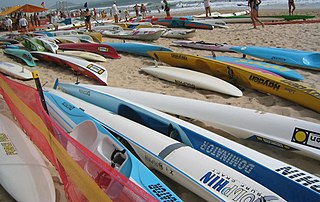
Surf lifesaving is a multifaceted movement that comprises key aspects of voluntary lifeguard services and competitive surf sport. Originating in early 20th century Australia, the movement has expanded globally to other countries including New Zealand, Ireland, South Africa, the United Kingdom. Surf lifesavers in Australia are colloquially known as "Clubbies".

Bondi Beach is a popular beach and the name of the surrounding suburb in Sydney, New South Wales, Australia. Bondi Beach is located 7 km (4 mi) east of the Sydney central business district, in the local government area of Waverley Council, in the Eastern Suburbs. It has a population of 11,656 residents. Its post code is 2026. Bondi, North Bondi, and Bondi Junction are neighbouring suburbs. Bondi Beach is one of the most visited tourist sites in Australia.
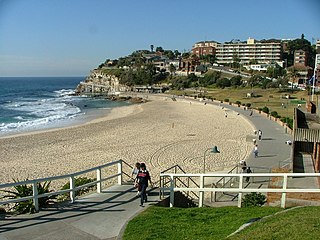
Bronte is a beachside suburb of Sydney, in the state of New South Wales, Australia. Bronte beach is located 7 kilometres east of the Sydney central business district, in the Waverley Council local government area of the Eastern Suburbs.

Coogee is a beachside suburb of local government area City of Randwick 8 kilometres south-east of the Sydney central business district, in the state of New South Wales, Australia. It is also a part of the Eastern Suburbs region.

Waverley Council is a Local government area in the eastern suburbs of Sydney, in the state of New South Wales, Australia. First incorporated on 16 June 1859 as the Municipality of Waverley, it is one of the oldest-surviving local government areas in New South Wales. Waverley is bounded by the Tasman Sea to the east, the Municipality of Woollahra to the north, and the City of Randwick in the south and west. The administrative centre of Waverley Council is located on Bondi Road in Bondi Junction in the Council Chambers on the corner of Waverley Park.

Maroubra is a beachside suburb in the Eastern Suburbs of Sydney, in the state of New South Wales, Australia. It is 10 kilometres south-east of the Sydney central business district in the local government area of the City of Randwick.
Tamarama is a beachside suburb, eastern suburb of Sydney, in the state of New South Wales, Australia. Tamarama is 6 kilometres east of the Sydney central business district, in the local government area of Waverley Council.
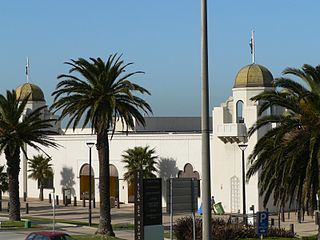
The St Kilda Sea Baths is a pool, spa, food and entertainment complex on St Kilda Beach, Victoria, Australia. Numerous 'seabath' structures have come and gone on the St Kilda foreshore, the last built in a Spanish- Moorish style in 1931, which was demolished in the 1990s and replaced by the present structure, partly reconstructing the 1931 baths.
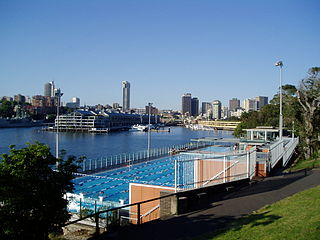
Andrew "Boy" Charlton Pool is an eight-lane outdoor heated salt-water 50-metre (55 yd) swimming pool on the shore of Woolloomooloo Bay in The Domain in Sydney, Australia, near the Royal Botanic Gardens. The pool is typically closed for four months in the colder period of the year - May through August.
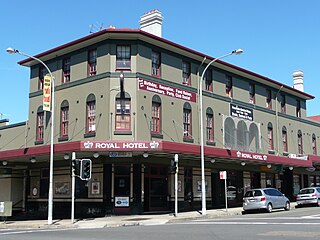
Bondi Road is a road in the Sydney suburb of Bondi, Australia. The road traverses east from Oxford Street in Bondi Junction to Campbell Parade, Bondi Beach. It is 1.8 kilometres long and is located in the local government area of Waverley Council.

Wylie's Baths is a heritage-listed tidal swimming pool located near Coogee Beach, in the Eastern Suburbs of Sydney, New South Wales, Australia. The baths are noted for holding the first Australian Swimming Championships and for being one of the first swimming baths for mixed gender swimming in Australia. The Baths were added to the New South Wales State Heritage Register on 14 November 2003 and are also classified by the National Trust of Australia.

The 1907 Sydney bathing costume protests were a response to a proposed ordinance by the Waverly Shire Council to require the wearing of a skirt-like tunic by male bathers. On the morning of Sunday 20 October, thousands of surf bathing enthusiasts poured onto the sands of Bondi, Manly, and Coogee beaches in various types of feminine dress enacting a humorous mockery of the proposed regulations. The protest at Bondi was reportedly the largest of the three, with a "swarm of humanity" participating in and observing the protests. The positivity with which the protests were regarded by both the general public and the media proved the end for the Waverly council's costume proposal; the tunic/skirt ordinance was not included in the beach ordinances promulgated in the following months.

The Bogey Hole, also known as the Commandant's Baths, is a heritage-listed sea bath in Newcastle in New South Wales, Australia. It is thought to be the oldest surviving European construction in the city area. The pool was hewn from a sandstone/conglomerate rock shelf at the base of cliffs near Shepherds Hill. Lieutenant-Colonel James Thomas Morisset, the Commandant of Newcastle (1818–23), ordered the construction of the pool by convict labour in about 1820 for his own use.

The Bondi Surf Bathers' Life Saving Club is Australia's oldest Surf Life Saving Club, founded in 1907. The club was officially established on 21 February 1907 at the Royal Hotel in Bondi Beach, Sydney, New South Wales. The clubs aim is to ensure "No Lives Lost" at Bondi Beach and is a volunteer organisation that patrols Bondi Beach from October to April every year.

Main Beach Pavilion and Southport Surf Lifesaving Club are heritage-listed beach buildings off Macarthur Parade, Main Beach, Queensland, Australia. The Main Beach Pavilion was designed by Thomas Ramsay Hall and Lionel Blythewood Phillips of the architectural firm Hall and Phillips and built in 1934 for the Southport Town Council. The Surf Lifesaving Club was also designed by Hall and Phillips and built adjacent in 1936 for the club. They were added to the Queensland Heritage Register on 1 March 1995.
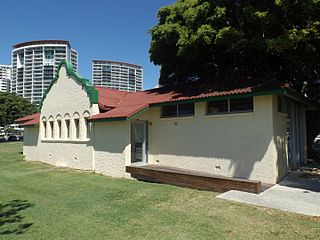
Southport Bathing Pavilion is a heritage-listed changing rooms at Marine Parade, Southport, Gold Coast City, Queensland, Australia. It was designed by Hall & Phillips and built in 1934 by A. Ledbury. It was added to the Queensland Heritage Register on 13 January 1995.
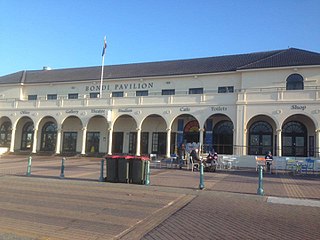
The Bondi Beach Cultural Landscape is a heritage-listed former Turkish baths, pavilion with dressing cubicles, dining rooms, sunbaking, shops and ballroom and now art gallery, pavilion, theatre and open air cinema located at Queen Elizabeth Drive, Bondi Beach, Waverley Municipality, Sydney, New South Wales, Australia. The pavilion was designed by Robertson and Marks, with Leith C. McCredie the architect. The Bondi Surf Life Savers' Club, erected c. 1934, was designed by Ross & Rowe. The Bondi Pavilion was designed by John Howie & Sons. The cultural landscape includes the beach itself, Bondi Surf Pavilion, Bondi Park and Bondi Surf Life Saving Club and the North Bondi Surf Club. The landscape was added to the New South Wales State Heritage Register on 23 May 2008.

North Beach Precinct is a heritage-listed precinct at Cliff Road, North Wollongong, City of Wollongong, New South Wales, Australia. It includes North Wollongong Beach, the North Beach/Wollongong Bathing Pavilion, Puckey's Salt Works, the Tram Cutting, Battery Park and Smiths Hill. It was added to the New South Wales State Heritage Register on 17 June 2005.

The Balmoral Bathers Pavilion is a heritage-listed former bathers' pavilion and now retail building, cafe and restaurant located at The Esplanade, Balmoral in the Mosman Council local government area of New South Wales, Australia. It was designed by Alfred H. Hale, the Mosman Council Architect and Building Surveyor and built from 1928 to 1929 by Girvan Brothers, Master Builders. The property is owned by Mosman Council. It was added to the New South Wales State Heritage Register on 2 April 1999.

Bondi Beach Post Office is a heritage-listed post office at 20 Hall Street, Bondi Beach, Sydney, New South Wales, Australia. It was added to the Australian Commonwealth Heritage List on 22 August 2012.




























